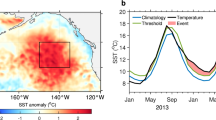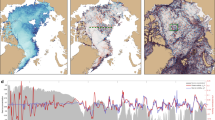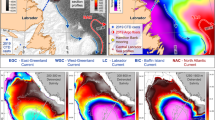Abstract
The air–sea transfer of heat and fresh water plays a critical role in the global climate system1. This is particularly true for the Greenland and Iceland seas, where these fluxes drive ocean convection that contributes to Denmark Strait overflow water, the densest component of the lower limb of the Atlantic Meridional Overturning Circulation (AMOC; ref. 2). Here we show that the wintertime retreat of sea ice in the region, combined with different rates of warming for the atmosphere and sea surface of the Greenland and Iceland seas, has resulted in statistically significant reductions of approximately 20% in the magnitude of the winter air–sea heat fluxes since 1979. We also show that modes of climate variability other than the North Atlantic Oscillation (NAO; refs 3, 4, 5, 6, 7) are required to fully characterize the regional air–sea interaction. Mixed-layer model simulations imply that further decreases in atmospheric forcing will exceed a threshold for the Greenland Sea whereby convection will become depth limited, reducing the ventilation of mid-depth waters in the Nordic seas. In the Iceland Sea, further reductions have the potential to decrease the supply of the densest overflow waters to the AMOC (ref. 8).
This is a preview of subscription content, access via your institution
Access options
Subscribe to this journal
Receive 12 print issues and online access
$209.00 per year
only $17.42 per issue
Buy this article
- Purchase on Springer Link
- Instant access to full article PDF
Prices may be subject to local taxes which are calculated during checkout




Similar content being viewed by others
References
Curry, J. A. et al. Seaflux. Bull. Am. Meteorol. Soc. 85, 409–424 (2004).
Mauritzen, C. Production of dense overflow waters feeding the North Atlantic across the Greenland-Scotland Ridge.1. Evidence for a revised circulation scheme. Deep-Sea Res. I 43, 769–806 (1996).
Dickson, B. From the Labrador Sea to global change. Nature 386, 649–650 (1997).
Hurrell, J. W. Decadal trends in the North-Atlantic Oscillation—regional temperatures and precipitation. Science 269, 676–679 (1995).
Jahnke-Bornemann, A. & Bruemmer, B. The Iceland-Lofotes pressure difference: Different states of the North Atlantic low-pressure zone. Tellus A 61, 466–475 (2009).
Moore, G. W. K., Renfrew, I. A. & Pickart, R. S. Spatial distribution of air–sea heat fluxes over the sub-polar North Atlantic Ocean. Geophys. Res. Lett. 39, L18806 (2012).
Moore, G. W. K., Renfrew, I. A. & Pickart, R. S. Multidecadal mobility of the North Atlantic oscillation. J. Clim. 26, 2453–2466 (2013).
Våge, K. et al. Significant role of the North Icelandic Jet in the formation of Denmark Strait overflow water. Nature Geosci. 4, 723–727 (2011).
Titchner, H. A. & Rayner, N. A. The Met Office Hadley Centre Sea Ice and Sea Surface Temperature Data Set, version 2: 1. Sea ice concentrations. J. Geophys. Res. 119, 2864–2889 (2014).
Bengtsson, L., Semenov, V. A. & Johannessen, O. M. The early twentieth-century warming in the Arctic - A possible mechanism. J. Clim. 17, 4045–4057 (2004).
Shindell, D. & Faluvegi, G. Climate response to regional radiative forcing during the twentieth century. Nature Geosci. 2, 294–300 (2009).
Fauria, M. M. et al. Unprecedented low twentieth century winter sea ice extent in the Western Nordic Seas since AD 1200. Clim. Dynam. 34, 781–795 (2010).
Marshall, J. & Schott, F. Open-ocean convection: Observations, theory, and models. Rev. Geophys. 37, 1–64 (1999).
Swift, J. H., Aagaard, K. & Malmberg, S. A. Contribution of the Denmark Strait overflow to the deep North-Atlantic. Deep-Sea Res. A 27, 29–42 (1980).
Renfrew, I. A. & Moore, G. W. K. An extreme cold-air outbreak over the Labrador Sea: Roll vortices and air–sea interaction. Mon. Weath. Rev. 127, 2379–2394 (1999).
Uppala, S. M. et al. The ERA-40 re-analysis. Q. J. R. Meteorol. Soc. 131, 2961–3012 (2005).
Dee, D. P. et al. The ERA-Interim reanalysis: Configuration and performance of the data assimilation system. Q. J. R. Meteorol. Soc. 137, 553–597 (2011)
Ghil, M. et al. Advanced spectral methods for climatic time series. Rev. Geophys. 40, 1003 (2002).
Kelly, P. M., Goodess, C. M. & Cherry, B. S. G. The interpretation of the Icelandic sea ice record. J. Geophys. Res. 92, 10835–10843 (1987).
Renfrew, I. A., Moore, G. W. K., Guest, P. S. & Bumke, K. A comparison of surface layer and surface turbulent flux observations over the Labrador Sea with ECMWF analyses and NCEP reanalyses. J. Phys. Oceanogr. 32, 383–400 (2002).
Price, J. F., Weller, R. A. & Pinkel, R. Diurnal cycling: Observations and models of the upper ocean response to diurnal heating, cooling, and wind mixing. J. Geophys. Res. 91, 8411–8427 (1986).
Nilsen, J. E. Ø., Hatun, H., Mork, K. A. & Valdimarsson, H. The NISE Data Set (Faroese Fisheries Laboratory, 2008).
Ronski, S. & Budeus, G. Time series of winter convection in the Greenland Sea. J. Geophys. Res. 110, C04015 (2005).
Våge, K., Pickart, R. S., Moore, G. W. K. & Ribergaard, M. H. Winter mixed-layer development in the central Irminger Sea: The effect of strong, intermittent wind events. J. Phys. Oceanogr. 38, 541–565 (2008).
Smeed, D. A. et al. Observed decline of the Atlantic meridional overturning circulation 2004–2012. Ocean Sci. 10, 29–38 (2014).
Rahmstorf, S. et al. Exceptional twentieth-century slowdown in Atlantic Ocean overturning circulation. Nature Clim. Change 5, 475–480 (2015).
Wood, R. A., Keen, A. B., Mitchell, J. F. B. & Gregory, J. M. Changing spatial structure of the thermohaline circulation in response to atmospheric CO2 forcing in a climate model. Nature 399, 572–575 (1999).
Bryden, H. L., Longworth, H. R. & Cunningham, S. A. Slowing of the Atlantic meridional overturning circulation at 25° N. Nature 438, 655–657 (2005).
Kuhlbrodt, T. et al. On the driving processes of the Atlantic meridional overturning circulation. Rev. Geophys. 45, RG2001 (2007).
Sutherland, D. A. & Pickart, R. S. The East Greenland Coastal Current: Structure, variability, and forcing. Prog. Oceanogr. 78, 58–77 (2008).
Acknowledgements
The authors would like to thank the European Centre for Medium-Range Weather Forecasts for access to the ERA-40 and ERA-I reanalyses. G.W.K.M. was supported by the Natural Sciences and Engineering Research Council of Canada. K.V. has received funding from NACLIM, a project of the European Union 7th Framework Programme (FP7 2007–2013) under grant agreement no. 308299, and from the Research Council of Norway under grant agreement no. 231647. R.S.P. was supported by the US National Science Foundation. I.A.R. has received funding from the Natural Environmental Research Council for the ACCACIA project (NE/I028297/1).
Author information
Authors and Affiliations
Contributions
G.W.K.M., K.V., R.S.P. and I.A.R. jointly conceived the study. G.W.K.M. analysed the atmospheric reanalyses and sea-ice data sets. K.V. carried out the ocean mixed-layer modelling. All authors jointly interpreted the results and wrote the manuscript.
Corresponding author
Ethics declarations
Competing interests
The authors declare no competing financial interests.
Supplementary information
Rights and permissions
About this article
Cite this article
Moore, G., Våge, K., Pickart, R. et al. Decreasing intensity of open-ocean convection in the Greenland and Iceland seas. Nature Clim Change 5, 877–882 (2015). https://doi.org/10.1038/nclimate2688
Received:
Accepted:
Published:
Issue Date:
DOI: https://doi.org/10.1038/nclimate2688
This article is cited by
-
Role of air-sea heat flux on the transformation of Atlantic Water encircling the Nordic Seas
Nature Communications (2023)
-
Human-induced changes in the global meridional overturning circulation are emerging from the Southern Ocean
Communications Earth & Environment (2023)
-
Thick and old sea ice in the Beaufort Sea during summer 2020/21 was associated with enhanced transport
Communications Earth & Environment (2022)
-
Sea-ice retreat suggests re-organization of water mass transformation in the Nordic and Barents Seas
Nature Communications (2022)
-
Sources and upstream pathways of the densest overflow water in the Nordic Seas
Nature Communications (2020)



